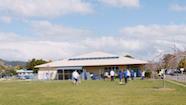Dave Dobbin inspires his year 13 students to learn about renewable energy.
Renewable energy: Teaching programme
Transcript
David Dobbin: I went and studied technology at Massey University and from there went into heavy industry really, mainly in pulp and paper, as a technologist. After sixteen years in that industry, I went into energy efficiency and so that gave me a good background in solar water heating, photovoltaics, space heating, heat pumps, all of that stuff that leads to reducing energy demand, and cost, the cost of living, and so forth.
So I’ve been a convert now for quite some time, so when I came to Trident High School, that was a natural progression for me to think, “Technology, my background is energy and this is a really current topic out there in the environment, and I could build a year 13 programme that was current and exciting for me and I could share that passion with my kids”.
That caused us to really look at renewable energy and energy efficiency at the school. So in the first year, we focused on solar water heating and the kids researched all the types of solar water heating that is current, so current technologies including evacuated tube systems, flat panel systems, DIY systems that people build for themselves using plastics and coppers and a whole range of materials. In that year the kids focused on flat panels of different construction and took home for themselves a fully functional model that heated a litre of water passively from the sun which they measured efficiency, temperature gain over time, knowing the radiance that’s landing and so forth.
So they made these models and they raced them competitively and then from that, on the ones that were most successful, analysed exactly why they were successful, and then based on that advice, two full-scale systems that, one of which, is still on the roof today, four years later, feeding our solar water heating system and hot water cylinder in the corner over there that they installed.
The next year we got into photovoltaics. So we got into identifying what silicon cells were and imported some from Silicon Valley in the States. The kids had to look at an authentic need at home. For some of them of course, it was powering iPods, for some it was laptops, for some it was cars, for their car chargers, powering a caravan. So they looked at an authentic need that they really had and wanted, and they designed a solution using an array of photovoltaic cells of all differing sizes and number of cells.
Then we raced them competitively too, looking at their briefs they had developed and who was the closest to satisfying that brief in terms of volts, watts, current, temperature gain and all those sorts of things on the panel.
And this year was the most exciting of all. We’ve ended up with four renewable energy technologies that are real and they are installed and they are generating electricity and they stay at school, they become teaching resources. So those systems are in, to their specification and the next step for several of them would be then to refine them further which is part of the project teams this year, to evaluate the performance of these systems and then make recommendations on design refinements for the future. For example, with the microhydro system, have a flow control system with solenoid control. You can even see that a system like that, which has been manually opened, could be integrating with ICT, with Arduino programming that could control solenoid valves, that can open actuators and things like that. A lot of that will be decided by the project group, the team, the student group next year in terms of, these will be some options that I see, what options do they see, and we co-construct those project type.
Well I’ve picked up mostly Level 3 technology achievement standards. There’s a safety unit standard, but we’ve also integrated in there an environmental sustainability achievement standard which is about a personal action plan for improving sustainability. We also have, (which we’ve done for two years now) we’ve picked up a physics assessment that our Head of Physics assesses. It’s a problem to stop them working, not to start them working on these projects.
I think too, that it’s really authentic. Renewable energy is a "now" topic. It’s so prevalent in media that kids know the topic. They study it in science and social sciences and stuff. Here they actually implement, rebuild, test, evaluate those very technologies that are being talked about as being the solutions of the future.
Related videos
Renewable energy: Solar panels (03:46)
Students developed a brief for their project based on an authentic context.
Renewable energy: Solar panels for special education (04:30)
Year 13 students embraced an opportunity to work alongside the special education centre.
Renewable energy: A model micro-hydro system (04:39)
Year 13 students explain their water powered turbine.
Renewable energy: Wind turbine (04:08)
A year 13 student and his teacher discuss their energy-saving project.
Renewable energy: Principal and community support (04:35)
Input from the community helped this school project to grow.
Manufacturing nesting boxes: Halo project (04:35)
A great story prompted students to get behind a community project.
Values: Halo project (02:23)
Year 11 students deepened curriculum understandings through helping their community.
Key Competencies: Halo Project (02:44)
This technology project has rich links to the key competencies.
Renewable energy: Solar water heating (04:20)
Year 13 students discuss their solar water heating project.









